Analysis of Forest Fire Emissions and Meteorological Impacts in Southwestern China Based on Multi-Source Satellite Observations
Abstract
1. Introduction
2. Materials and Methods
3. Results
3.1. Comparison Analysis
3.2. Emission Inventory of Air Pollutants
3.3. Comparison of Hotspot Numbers and Emission Characteristics
3.4. Characteristics Spatiotemporal Characteristics of Carbon Emissions
3.5. Meteorological Drivers and Their Impacts on Carbon Emissions
4. Discussion
4.1. Comparison with Database-Based Emission Results
4.2. Uncertainty Analysis
5. Conclusions
- (a)
- From 2016 to 2023, the annual average emissions of ten major pollutants from forest fires in southwestern China were CO2 (5623.58 ± 1554.33), CO (356.84 ± 98.63), PM2.5 (41.39 ± 11.44), PM10 (44.46 ± 12.29), VOCs (63.36 ± 17.51), NOx (9.45 ± 2.61), SO2 (2.98 ± 0.82), NH3 (4.86 ± 1.34), BC (2.04 ± 0.56), and OC (29.21 ± 8.08) (units: ×103 t·a−1). Among these, CO2 and CO were the dominant pollutants.
- (b)
- Spatially, Yunnan Province and Sichuan Province were the core contributors to CO2 emissions. Strengthening monitoring, early warning, and emission control in these two provinces is critical for maintaining regional carbon balance and improving air quality. Temporally, CO2 emissions were higher during daytime than at night and were concentrated between January–April and December.
- (c)
- CO2 emissions increased with rising temperature and decreased with precipitation, exhibiting the overall pattern of “high temperature promotes emissions, while humidity suppresses fires.” The emissions demonstrated nonlinear and interactive relationships with meteorological factors, with the strongest interaction between temperature and relative humidity in winter. Under cold-dry conditions, elevated temperatures combined with low humidity were more likely to trigger fires and amplify carbon emissions.
Author Contributions
Funding
Institutional Review Board Statement
Informed Consent Statement
Data Availability Statement
Conflicts of Interest
Abbreviations
| AHI | Advanced Himawari Imager |
| BC | Black Carbon |
| CO2 | Carbon Dioxide |
| ECMWF | European Centre for Medium-Range Weather Forecasts |
| ERA5-Land | ECMWF Re-Analysis 5-Land |
| FRP | Fire Radiative Power |
| FRE | Fire Radiative Energy |
| GFED5 | Global Fire Emissions Database version 5 |
| MODIS | Moderate Resolution Imaging Spectroradiometer |
| NH3 | Ammonia |
| NOX | Nitrogen Oxides (NO + NO2) |
| OC | Organic Carbon |
| PM2.5 | Fine Particulate Matter (aerodynamic diameter ≤ 2.5 μm) |
| PM10 | Inhalable Particulate Matter (aerodynamic diameter ≤ 10 μm) |
| RH | Relative Humidity |
| SO2 | Sulfur Dioxide |
| VOCs | Volatile Organic Compounds |
| VIIRS | Visible Infrared Imaging Radiometer Suite |
References
- IPCC. Climate Change 2021: The Physical Science Basis. In Contribution of Working Group I to the Sixth Assessment Report of the Intergovernmental Panel on Climate Change; Cambridge University Press: Cambridge, UK, 2021. [Google Scholar]
- Pimm, S.L.; Raven, P. Extinction by numbers. Nature 2000, 403, 843–845. [Google Scholar] [CrossRef]
- Garcia-Hurtado, E.; Pey, J.; Borrás, E.; Sánchez, P.; Vera, T.; Carratalá, A.; Alastuey, A.; Querol, X.; Vallejo, V.R. Atmospheric PM and volatile organic compounds released from Mediterranean shrubland wildfires. Atmos. Environ. 2014, 89, 303–311. [Google Scholar] [CrossRef]
- Guo, Y.X.; Wei, M.; Tian, M.Y.; Sun, X.Y.; Zheng, W.X.; Ma, Y.F.; Guo, F.T. Characteristics of smoke and particulate matter released by combustion of eight main tree species in Yunnan Province. Res. Environ. Sci. 2021, 34, 2295–2305. [Google Scholar]
- Park, C.Y.; Takahashi, K.; Fujimori, S.; Jansakoo, T.; Burton, C.; Huang, H.; Kou-Giesbrecht, S.; Reyer, C.P.O.; Mengel, M.; Burke, E.; et al. Attributing human mortality from fire PM2.5 to climate change. Nat. Clim. Change 2024, 14, 1193–1200. [Google Scholar] [CrossRef]
- Wang, M.; Jiang, C.; Sun, O.J. Spatially differentiated changes in regional climate and underlying drivers in southwestern China. J. For. Res. 2022, 33, 755–765. [Google Scholar] [CrossRef]
- Tian, X.R.; Zhao, F.J.; Shu, L.F.; Wang, M.Y. Hotspots from satellite monitoring and forest fire weather index analysis for Southwest China. For. Res. 2010, 23, 523–529. [Google Scholar]
- Ning, X.C.; Li, J.W.; Zhuang, P.K.; Lai, S.F.; Zheng, X.G. Wildfire combustion emission inventory in Southwest China (2001–2020) based on MODIS fire radiative energy data. Atmos. Pollut. Res. 2024, 15, 102279. [Google Scholar] [CrossRef]
- He, J.; Zhang, Y. Analysis of the impacts of meteorological factors on forest fire danger in the conterminous United States. J. Geophys. Res. Atmos. 2021, 126, e2021JD035376. [Google Scholar] [CrossRef]
- Lund, M.T.; Nordling, K.; Gjelsvik, A.B.; Samset, B.H. The influence of variability on fire weather conditions in high latitude regions under present and future global warming. Environ. Res. Commun. 2023, 5, 065016. [Google Scholar] [CrossRef]
- Feng, Y.; Lei, C.F.; Pan, Y.; Zhang, C.J. Forest fire monitoring based on satellite remote sensing technology. Geomat. Technol. Equip. 2022, 24, 15–19. [Google Scholar]
- Justice, C.O.; Vermote, E.; Townshend, J.R.G.; Defries, R.; Roy, D.P.; Hall, D.K. The Moderate Resolution Imaging Spectroradiometer (MODIS): Land remote sensing for global change research. IEEE Trans. Geosci. Remote Sens. 1998, 36, 1228–1249. [Google Scholar] [CrossRef]
- Giglio, L.; Descloitres, J.; Justice, C.O.; Kaufman, Y.J. An enhanced contextual fire detection algorithm for MODIS. Remote Sens. Environ. 2003, 87, 273–282. [Google Scholar] [CrossRef]
- Schroeder, W.; Oliva, P.; Giglio, L.; Csiszar, I.A. The new VIIRS 375 m active fire detection data product: Algorithm description and initial assessment. Remote Sens. Environ. 2014, 143, 85–96. [Google Scholar] [CrossRef]
- Chen, J.; Lv, Q.; Wu, S.; Zeng, Y.; Li, M.; Chen, Z.; Zhou, E.; Zheng, W.; Liu, C.; Chen, X.; et al. An adapted hourly Himawari-8 fire product for China: Principle, methodology and verification. Earth Syst. Sci. Data 2023, 15, 1911–1931. [Google Scholar] [CrossRef]
- Lu, X.M.; Zhang, X.Y.; Li, F.J.; Cochrane, M.A. Improved estimation of fire particulate emissions using a combination of VIIRS and AHI data for Indonesia during 2015–2020. Remote Sens. Environ. 2022, 281, 113238. [Google Scholar] [CrossRef]
- Zheng, Y.M.; Liu, J.; Jian, H.D.; Fan, X.T.; Yan, F.L. Fire diurnal cycle derived from a combination of the Himawari-8 and VIIRS satellites to improve fire emission assessments in Southeast Australia. Remote Sens. 2021, 13, 2852. [Google Scholar] [CrossRef]
- Wickramasinghe, C.H.; Wallace, L.; Reinke, K.; Jones, S. Intercomparison of Himawari-8 AHI-FSA with MODIS and VIIRS active fire products. Int. J. Digit. Earth 2020, 13, 457–473. [Google Scholar] [CrossRef]
- Wooster, M.J.; Roberts, G.; Perry, G.L.W.; Kaufman, Y.J. Retrieval of biomass combustion rates and totals from fire radiative power observations: FRP derivation and calibration relationships between biomass consumption and fire radiative energy release. J. Geophys. Res. Atmos. 2005, 110, D24311. [Google Scholar] [CrossRef]
- Liu, M.X.; Song, Y.; Yao, H.; Kang, Y.N.; Li, M.M.; Huang, X.; Hu, M. Estimating emissions from agricultural fires in the North China Plain based on MODIS fire radiative power. Atmos. Environ. 2015, 112, 326–334. [Google Scholar] [CrossRef]
- Vermote, E.; Ellicott, E.; Dubovik, O.; Lapyonok, T.; Chin, M.; Giglio, L.; Roberts, G.J. An approach to estimate global biomass burning emissions of organic and black carbon from MODIS fire radiative power. J. Geophys. Res. Atmos. 2009, 114, D18205. [Google Scholar] [CrossRef]
- Xu, Y.Q.; Huang, Z.J.; Ou, J.M.; Jia, G.L.; Wu, L.L.; Liu, H.L.; Lu, M.H.; Fan, M.; Wei, J.; Chen, L.F.; et al. Near-real-time estimation of hourly open biomass burning emissions in China using multiple satellite retrievals. Sci. Total Environ. 2022, 817, 152777. [Google Scholar] [CrossRef]
- Li, R.; Liu, J.X.; Zhang, M.D.; Huang, C.W.; Zhao, S.H.; Zhang, M.G.; Cheng, L.F. Development and analysis of a forest fire emission inventory in China considering daily variation patterns. Environ. Pollut. 2025, 382, 126720. [Google Scholar] [CrossRef] [PubMed]
- Kang, Y.; Im, J. Mitigating underestimation of fire emissions from the Advanced Himawari Imager: A machine learning and multi-satellite ensemble approach. Int. J. Appl. Earth Obs. Geoinf. 2024, 128, 103784. [Google Scholar] [CrossRef]
- Xu, Y.Q. Study on the Evolution Characteristics and Dynamic Representation of Open Biomass Burning Emissions in China. Ph.D. Thesis, South China University of Technology, Guangzhou, China, 2020. [Google Scholar]
- Anderson, L.D.; Dix, B.; Schnell, J.; Yokelson, R.; Veefkind, J.P.; Ahmadov, R.; de Gouw, J. Analyzing the impact of evolving combustion conditions on the composition of wildfire emissions using satellite data. Geophys. Res. Lett. 2023, 50, e2023GL105811. [Google Scholar] [CrossRef]
- Roy, D.P.; Boschetti, L.; Smith, A.M.S. Satellite remote sensing of fires. In Fire Phenomena and the Earth System; Wiley: Hoboken, NJ, USA, 2013; Chapter 5. [Google Scholar] [CrossRef]
- Santoso, M.A. Review of the transition from smouldering to flaming combustion in wildfires. Front. Mech. Eng. 2019, 5, 49. [Google Scholar] [CrossRef]
- Garg, P.; Wang, S.; Oakes, J.M.; Bellini, C.; Gollner, M.J. Variations in gaseous and particulate emissions from flaming and smouldering combustion of Douglas fir and lodgepole pine under different fuel moisture conditions. Combust. Flame 2024, 263, 113386. [Google Scholar] [CrossRef]
- Keeley, J.E. Fire intensity, fire severity and burn severity: A brief review and suggested usage. Int. J. Wildland Fire 2009, 18, 116–126. [Google Scholar] [CrossRef]
- Fernandes, P.M.; Botelho, H.S. A review of prescribed burning effectiveness in fire hazard reduction. Int. J. Wildland Fire 2003, 12, 117–128. [Google Scholar] [CrossRef]
- Andreae, M.O. Emission of trace gases and aerosols from biomass burning—An updated assessment. Atmos. Chem. Phys. 2019, 19, 8523–8546. [Google Scholar] [CrossRef]
- Streets, D.G.; Bond, T.C.; Carmichael, G.R.; Fernandes, S.D.; Fu, Q.; He, D.; Klimont, Z.; Nelson, S.M.; Tsai, N.Y.; Wang, M.Q.; et al. An inventory of gaseous and primary aerosol emissions in Asia in the year 2000. J. Geophys. Res. Atmos. 2003, 108, D21. [Google Scholar] [CrossRef]
- Andreae, M.O.; Merlet, P. Emission of trace gases and aerosols from biomass burning. Glob. Biogeochem. Cycles 2001, 15, 955–966. [Google Scholar] [CrossRef]
- Wu, J.; Kong, S.F.; Wu, F.Q.; Cheng, Y.; Zheng, S.R.; Yan, Q.; Zheng, H.; Yang, G.W.; Zheng, M.M.; Liu, D.T.; et al. Estimating the open biomass burning emissions in central and eastern China from 2003 to 2015. Atmos. Chem. Phys. 2018, 18, 11623–11646. [Google Scholar] [CrossRef]
- Freeborn, P.H.; Wooster, M.J.; Hao, W.M.; Ryan, C.A.; Nordgren, B.L.; Baker, S.P.; Ichoku, C. Relationships between energy release, fuel mass loss, and trace gas and aerosol emissions during laboratory biomass fires. J. Geophys. Res. Atmos. 2008, 113, D01301. [Google Scholar] [CrossRef]
- Song, Y.; Liu, B.; Miao, W.J.; Chang, D.; Zhang, Y.H. Spatiotemporal variation in nonagricultural open fire emissions in China from 2000 to 2007. Glob. Biogeochem. Cycles 2009, 23, GB2008. [Google Scholar] [CrossRef]
- Fan, H.; Yang, X.; Zhao, C.; Yang, Y.K.; Shen, Z.Y. Spatiotemporal variation characteristics of global fires and their emissions. Atmos. Chem. Phys. 2023, 23, 7781–7798. [Google Scholar] [CrossRef]
- Chen, Y.; Hall, J.; van Wees, D.; Andela, N.; Hantson, S.; Giglio, L.; van der Werf, G.R.; Morton, D.C.; Randerson, J.T. Multi-decadal trends and variability in burned area from the fifth version of the Global Fire Emissions Database (GFED5). Earth Syst. Sci. Data 2023, 15, 5227–5259. [Google Scholar] [CrossRef]
- Wang, J.F.; Xu, C.D. Geodetector: Principle and prospective. Acta Geogr. Sin. 2017, 72, 116–134. [Google Scholar] [CrossRef]
- Abatzoglou, J.T.; Williams, A.P. Impact of anthropogenic climate change on wildfire across western US forests. Proc. Natl. Acad. Sci. USA 2016, 113, 11770–11775. [Google Scholar] [CrossRef]
- Pimont, F.; Ruffault, J.; Martin-StPaul, N.K.; Dupuy, J.-L. Why is the effect of live fuel moisture content on fire rate of spread underestimated in field experiments in shrublands? Int. J. Wildland Fire 2019, 28, 127–137. [Google Scholar] [CrossRef]
- Ma, W.; Zhai, L.; Pivovaroff, A.; Shuman, J.; Buotte, P.; Ding, J.; Christoffersen, B.; Knox, R.; Moritz, M.; Fisher, R.A.; et al. Assessing climate change impacts on live fuel moisture and wildfire risk using a hydrodynamic vegetation model. Biogeosci. Discuss. 2021, 18, 4005–4020. [Google Scholar] [CrossRef]
- Fan, X.W.; Miao, C.Y.; Zscheischler, J.; Slater, L.; Wu, Y.; Chai, Y.; Aghakouchak, A. Escalating Hot-Dry Extremes Amplify Compound Fire Weather Risk. Earth’s Future 2023, 11, e2023EF003976. [Google Scholar] [CrossRef]
- Shao, Y.K.; Fan, G.P.; Feng, Z.K.; Sun, L.H.; Yang, X.H.; Ma, T.T.; Li, X.S.; Fu, H.N.; Wang, A.A. Prediction of Forest Fire Occurrence in China under Climate Change Scenarios. J. For. Res. 2023, 34, 1217–1228. [Google Scholar] [CrossRef]
- Van der Werf, G.R.; Randerson, J.T.; Giglio, L.; Van Leeuwen, T.T.; Chen, Y.; Rogers, B.M.; Mu, M.; Van Marle, M.J.E.; Morton, D.C.; Collatz, G.J.; et al. Global fire emissions estimates during 1997–2016. Earth Syst. Sci. Data 2017, 9, 697–720. [Google Scholar] [CrossRef]
- Hua, W.X.; Lou, S.J.; Huang, X.; Xue, L.; Ding, K.; Wang, Z.; Ding, A.J. Diagnosing uncertainties in global biomass burning emission inventories and their impact on modeled air pollutants. Atmos. Chem. Phys. 2024, 24, 6787–6807. [Google Scholar] [CrossRef]
- Minsavage-Davis, C.D.; Davies, G.M. Evaluating the Performance of Fire Rate of Spread Models in Northern-European Calluna vulgaris Heathlands. Fire 2022, 5, 46. [Google Scholar] [CrossRef]
- Zheng, B.; Chevallier, F.; Yin, Y.; Wang, Y.L. On the role of the flaming-to-smoldering transition in the seasonal cycle of African fire emissions. Geophys. Res. Lett. 2018, 45, 6633–6641. [Google Scholar] [CrossRef]
- Kaiser, J.W.; Heil, A.; Andreae, M.O.; Benedetti, A.; Chubarova, N.; Jones, L.; Morcrette, J.-J.; Razinger, M.; Schultz, M.G.; Suttie, M.; et al. Biomass burning emissions estimated with a global fire assimilation system based on observed fire radiative power. Biogeosciences 2012, 9, 527–554. [Google Scholar] [CrossRef]
- Andela, N.; Morton, D.C.; Giglio, L.; Chen, Y.; Van der Werf, G.R.; Kasibhatla, P.S.; DeFries, R.S.; Collatz, G.J.; Hantson, S.; Kloster, S.; et al. A human-driven decline in global burned area. Science 2017, 356, 1356–1362. [Google Scholar] [CrossRef]
- Roberts, G.; Wooster, M.J.; Lagoudakis, E. Annual and diurnal African biomass burning temporal dynamics. Biogeosciences 2009, 6, 849–866. [Google Scholar] [CrossRef]
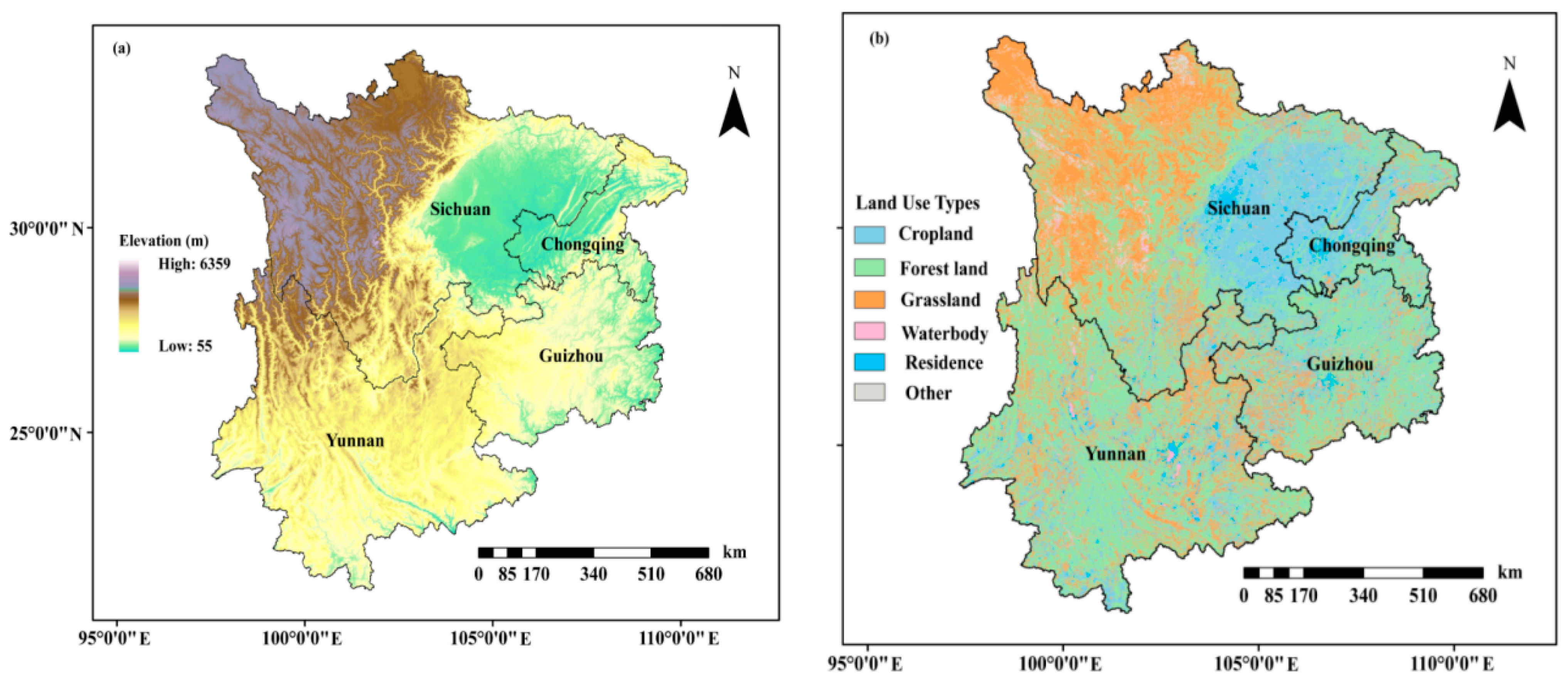
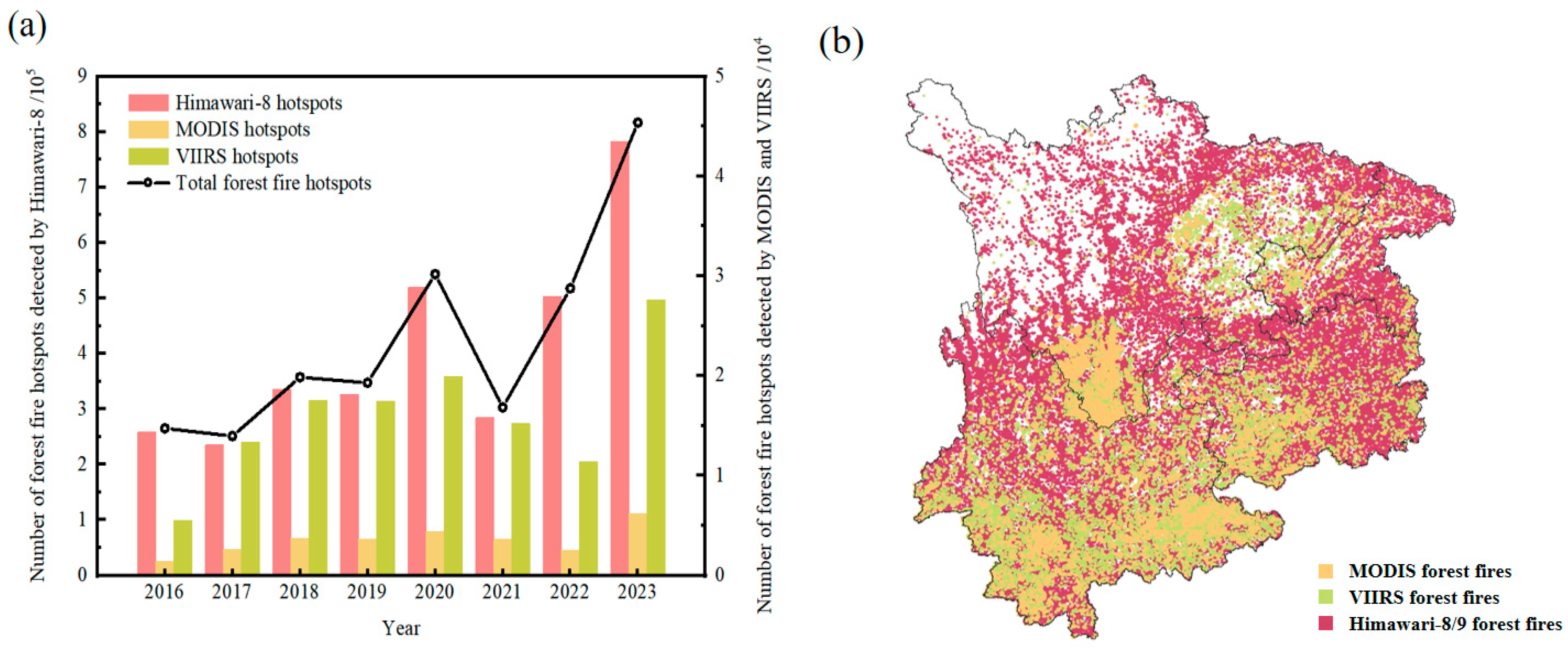
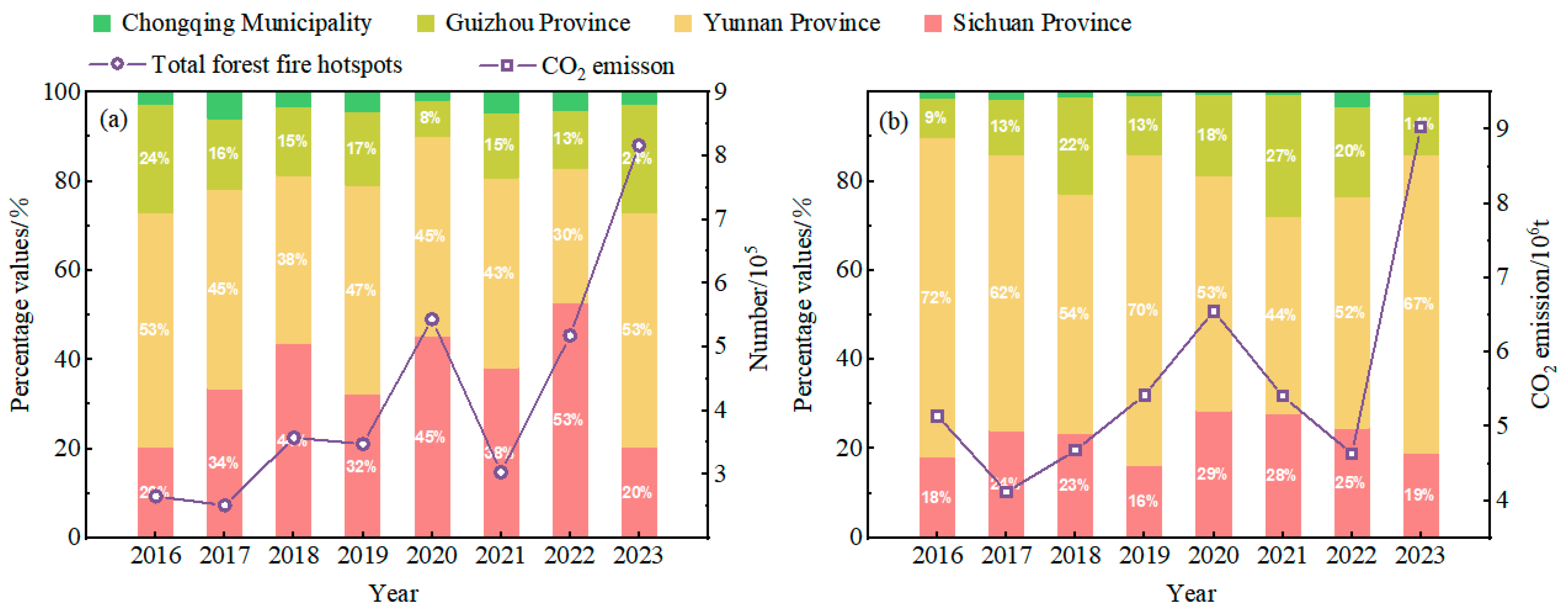
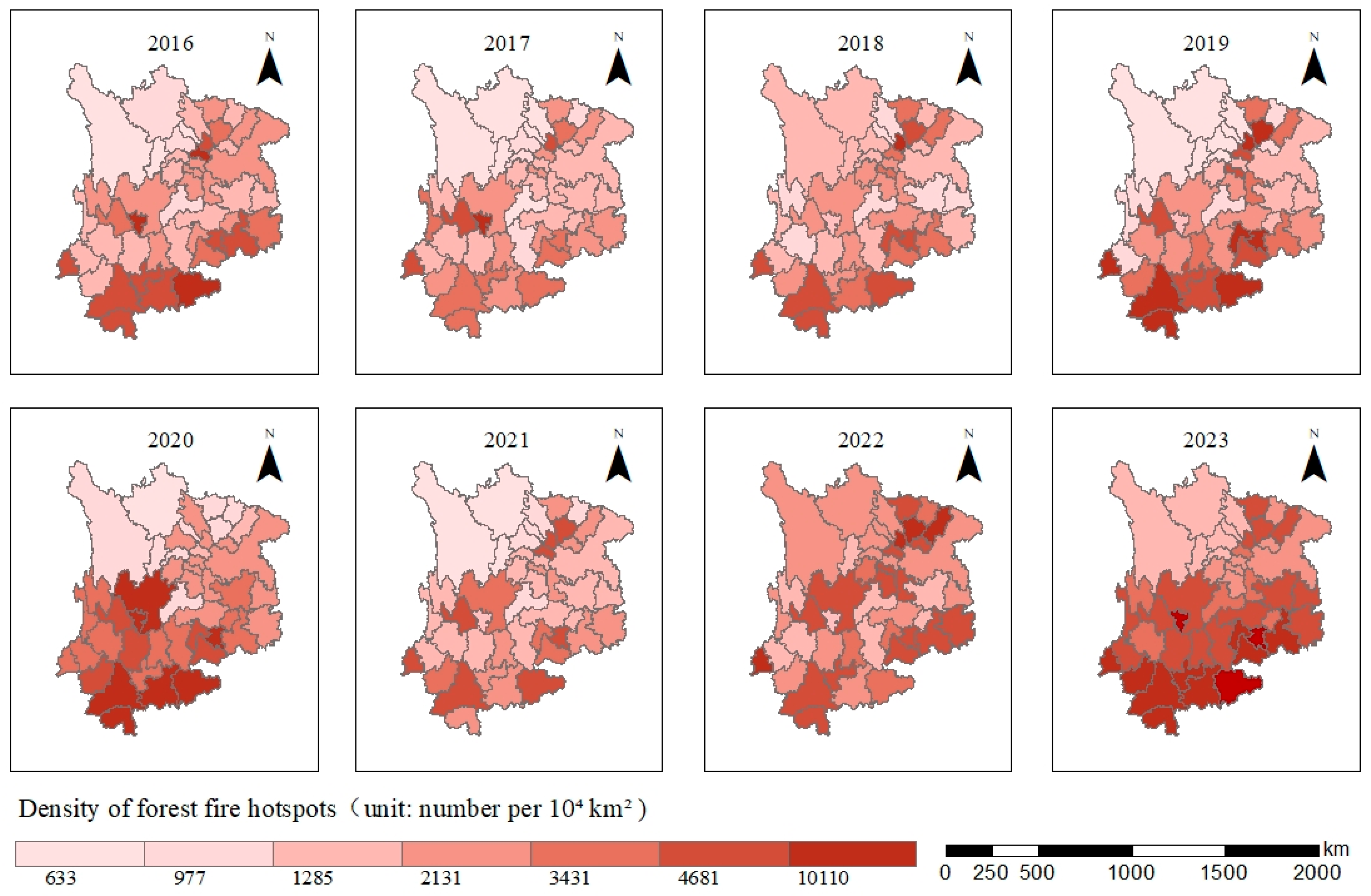
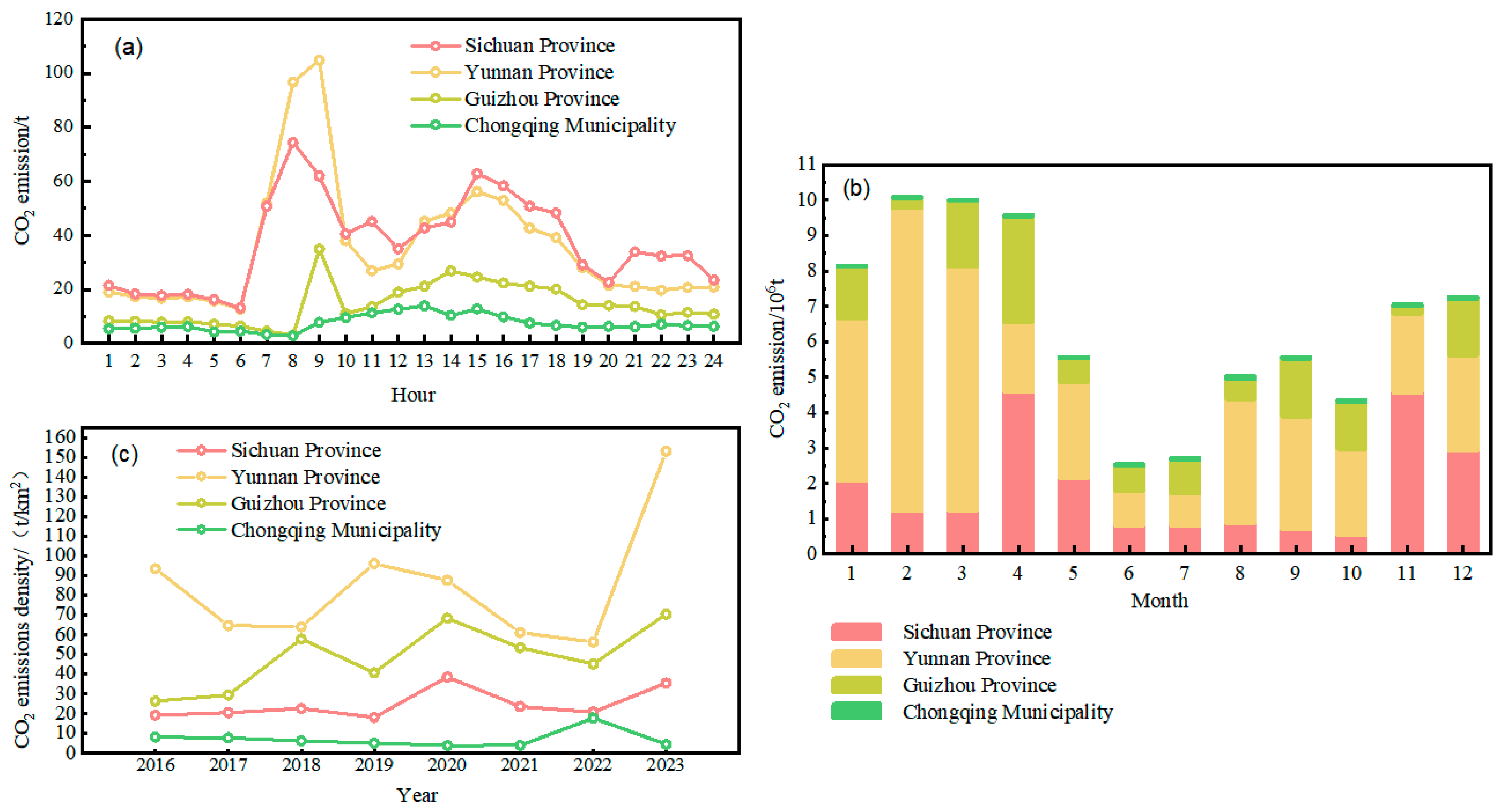

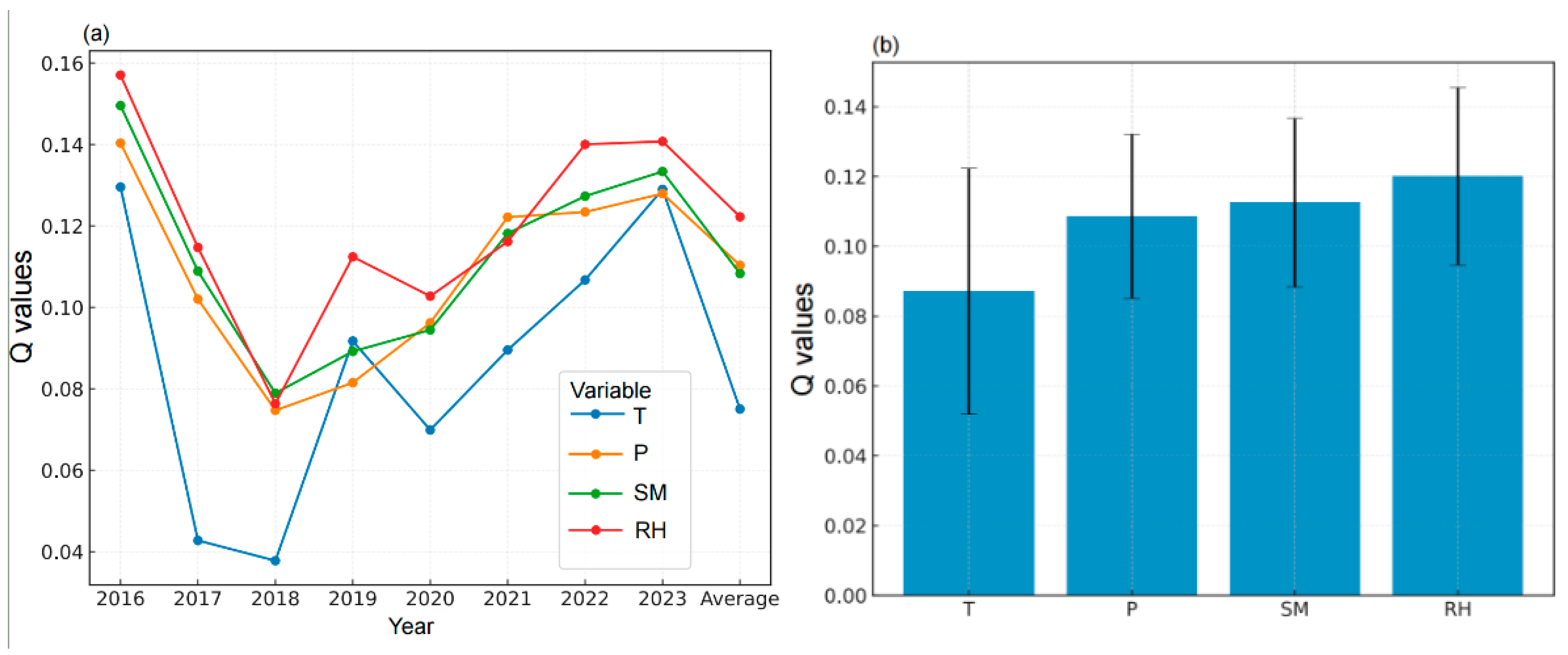
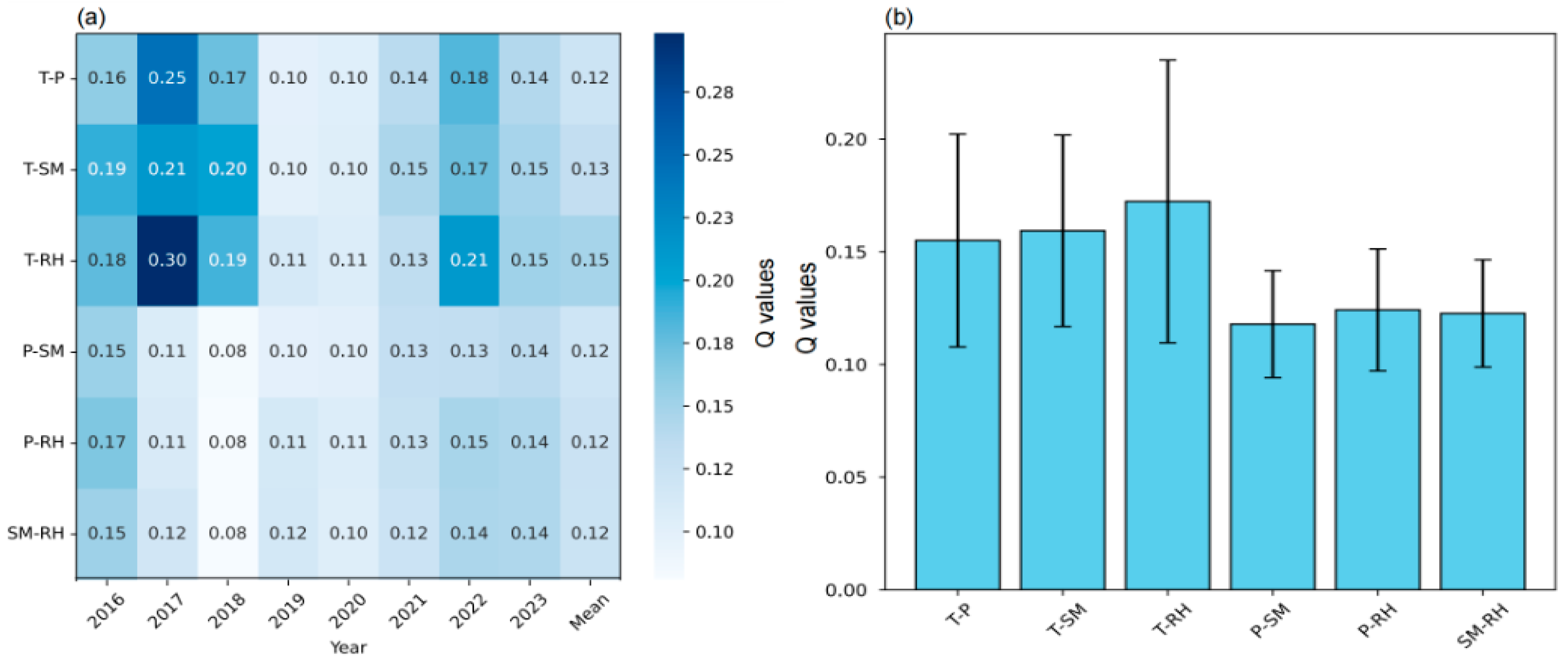
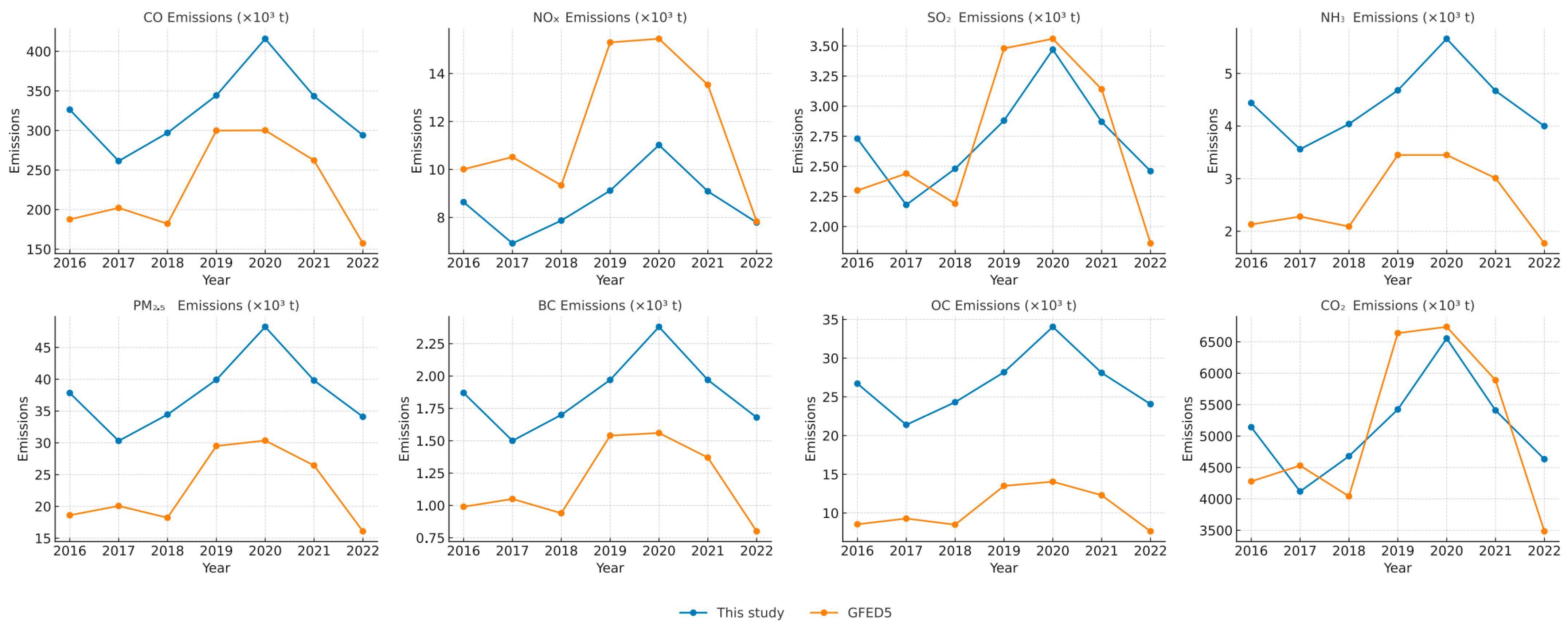
| CO2 | CO | PM2.5 | SO2 | NOX | OC | VOCS | NH3 | PM10 | BC | Reference |
|---|---|---|---|---|---|---|---|---|---|---|
| 664.20 | 42.64 | / | 0.29 | 1.23 | 4.47 | 5.49 | 0.40 | nan | 0.23 | [32] |
| 643.29 | 43.87 | nan | 0.41 | 1.23 | 3.75 | 11.39 | 0.57 | nan | 0.23 | [33] |
| 643.29 | 43.87 | 5.33 | 0.41 | 1.23 | 2.51 | 8.93 | 0.57 | 5.13 | 0.23 | [34] |
| 698.35 | 35.10 | 4.81 | 0.23 | 1.16 | 2.85 | 4.16 | 0.43 | 5.31 | 0.32 | Average [37] |
| 652.45 | 44.01 | 4.43 | 0.41 | 0.68 | 3.58 | 7.24 | 0.89 | nan | 0.19 | Average [35] |
| 660.32 | 41.90 | 4.86 | 0.35 | 1.11 | 3.43 | 7.44 | 0.57 | 5.22 | 0.24 | Overall Average |
| Year | CO | NOx | SO2 | NH3 | VOCs | PM2.5 | PM10 | BC | OC | CO2 | |
|---|---|---|---|---|---|---|---|---|---|---|---|
| 2016 | Guizhou | 29.29 | 0.78 | 0.24 | 0.40 | 5.20 | 3.40 | 3.65 | 0.17 | 2.40 | 461.59 |
| Sichuan | 59.01 | 1.56 | 0.49 | 0.80 | 10.48 | 6.84 | 7.35 | 0.34 | 4.83 | 929.96 | |
| Yunnan | 233.70 | 6.19 | 1.95 | 3.18 | 41.50 | 27.11 | 29.11 | 1.34 | 19.13 | 3682.98 | |
| Chongqing | 4.25 | 0.11 | 0.04 | 0.06 | 0.75 | 0.49 | 0.53 | 0.02 | 0.35 | 66.98 | |
| Total | 326.25 | 8.64 | 2.73 | 4.44 | 57.93 | 37.84 | 40.64 | 1.87 | 26.71 | 5141.51 | |
| 2017 | Guizhou | 32.69 | 0.87 | 0.27 | 0.44 | 5.80 | 3.79 | 4.07 | 0.19 | 2.68 | 515.18 |
| Sichuan | 63.03 | 1.67 | 0.53 | 0.86 | 11.19 | 7.31 | 7.85 | 0.36 | 5.16 | 993.32 | |
| Yunnan | 161.58 | 4.28 | 1.35 | 2.20 | 28.69 | 18.74 | 20.13 | 0.93 | 13.23 | 2546.41 | |
| Chongqing | 4.05 | 0.11 | 0.03 | 0.06 | 0.72 | 0.47 | 0.50 | 0.02 | 0.33 | 63.83 | |
| Total | 261.35 | 6.92 | 2.18 | 3.56 | 46.41 | 30.31 | 32.56 | 1.50 | 21.39 | 4118.73 | |
| 2018 | Guizhou | 64.56 | 1.71 | 0.54 | 0.88 | 11.46 | 7.49 | 8.04 | 0.37 | 5.28 | 1017.43 |
| Sichuan | 69.52 | 1.84 | 0.58 | 0.95 | 12.34 | 8.06 | 8.66 | 0.40 | 5.69 | 1095.60 | |
| Yunnan | 159.69 | 4.23 | 1.33 | 2.17 | 28.36 | 18.52 | 19.89 | 0.91 | 13.07 | 2516.62 | |
| Chongqing | 3.21 | 0.09 | 0.03 | 0.04 | 0.57 | 0.37 | 0.40 | 0.02 | 0.26 | 50.59 | |
| Total | 296.98 | 7.87 | 2.48 | 4.04 | 52.73 | 34.45 | 37.00 | 1.70 | 24.31 | 4680.23 | |
| 2019 | Guizhou | 45.44 | 1.20 | 0.38 | 0.62 | 8.07 | 5.27 | 5.66 | 0.26 | 3.72 | 716.11 |
| Sichuan | 55.83 | 1.48 | 0.47 | 0.76 | 9.91 | 6.48 | 6.96 | 0.32 | 4.57 | 879.85 | |
| Yunnan | 240.31 | 6.37 | 2.01 | 3.27 | 42.67 | 27.87 | 29.94 | 1.38 | 19.67 | 3787.15 | |
| Chongqing | 2.62 | 0.07 | 0.02 | 0.04 | 0.47 | 0.30 | 0.33 | 0.02 | 0.21 | 41.29 | |
| Total | 344.20 | 9.12 | 2.88 | 4.68 | 61.12 | 39.92 | 42.88 | 1.97 | 28.18 | 5424.39 | |
| 2020 | Guizhou | 76.25 | 2.02 | 0.64 | 1.04 | 13.54 | 8.84 | 9.50 | 0.44 | 6.24 | 1201.66 |
| Sichuan | 118.61 | 3.14 | 0.99 | 1.61 | 21.06 | 13.76 | 14.78 | 0.68 | 9.71 | 1869.15 | |
| Yunnan | 219.03 | 5.80 | 1.83 | 2.98 | 38.89 | 25.41 | 27.29 | 1.25 | 17.93 | 3451.80 | |
| Chongqing | 1.97 | 0.05 | 0.02 | 0.03 | 0.35 | 0.23 | 0.25 | 0.01 | 0.16 | 31.05 | |
| Total | 415.86 | 11.02 | 3.47 | 5.66 | 73.84 | 48.24 | 51.81 | 2.38 | 34.04 | 6553.65 | |
| 2021 | Guizhou | 93.83 | 2.49 | 0.78 | 1.28 | 16.66 | 10.88 | 11.69 | 0.54 | 7.68 | 1478.71 |
| Sichuan | 95.84 | 2.54 | 0.80 | 1.30 | 17.02 | 11.12 | 11.94 | 0.55 | 7.85 | 1510.38 | |
| Yunnan | 151.55 | 4.01 | 1.27 | 2.06 | 26.91 | 17.58 | 18.88 | 0.87 | 12.41 | 2388.34 | |
| Chongqing | 2.03 | 0.05 | 0.02 | 0.03 | 0.36 | 0.24 | 0.25 | 0.01 | 0.17 | 31.99 | |
| Total | 343.25 | 9.09 | 2.87 | 4.67 | 60.95 | 39.81 | 42.76 | 1.97 | 28.10 | 5409.42 | |
| 2022 | Guizhou | 59.60 | 1.58 | 0.50 | 0.81 | 10.58 | 6.91 | 7.43 | 0.34 | 4.88 | 939.26 |
| Sichuan | 72.47 | 1.92 | 0.61 | 0.99 | 12.87 | 8.41 | 9.03 | 0.42 | 5.93 | 1142.09 | |
| Yunnan | 152.61 | 4.04 | 1.27 | 2.08 | 27.10 | 17.70 | 19.01 | 0.87 | 12.49 | 2405.05 | |
| Chongqing | 9.27 | 0.25 | 0.08 | 0.13 | 1.65 | 1.08 | 1.15 | 0.05 | 0.76 | 146.09 | |
| Total | 293.95 | 7.79 | 2.46 | 4.00 | 52.20 | 34.10 | 36.62 | 1.68 | 24.06 | 4632.48 | |
| 2023 | Guizhou | 78.61 | 2.08 | 0.66 | 1.07 | 13.96 | 9.12 | 9.79 | 0.45 | 6.44 | 1238.85 |
| Sichuan | 108.94 | 2.89 | 0.91 | 1.48 | 19.34 | 12.64 | 13.57 | 0.62 | 8.92 | 1716.83 | |
| Yunnan | 383.00 | 10.15 | 3.20 | 5.21 | 68.01 | 44.42 | 47.72 | 2.19 | 31.35 | 6035.86 | |
| Chongqing | 2.33 | 0.06 | 0.02 | 0.03 | 0.41 | 0.27 | 0.29 | 0.01 | 0.19 | 36.72 | |
| Total | 572.88 | 15.18 | 4.79 | 7.79 | 101.72 | 66.45 | 71.37 | 3.28 | 46.90 | 9028.26 |
Disclaimer/Publisher’s Note: The statements, opinions and data contained in all publications are solely those of the individual author(s) and contributor(s) and not of MDPI and/or the editor(s). MDPI and/or the editor(s) disclaim responsibility for any injury to people or property resulting from any ideas, methods, instructions or products referred to in the content. |
© 2025 by the authors. Licensee MDPI, Basel, Switzerland. This article is an open access article distributed under the terms and conditions of the Creative Commons Attribution (CC BY) license (https://creativecommons.org/licenses/by/4.0/).
Share and Cite
Fang, L.; Han, Y.; Lin, J.; Guo, W. Analysis of Forest Fire Emissions and Meteorological Impacts in Southwestern China Based on Multi-Source Satellite Observations. Atmosphere 2025, 16, 1187. https://doi.org/10.3390/atmos16101187
Fang L, Han Y, Lin J, Guo W. Analysis of Forest Fire Emissions and Meteorological Impacts in Southwestern China Based on Multi-Source Satellite Observations. Atmosphere. 2025; 16(10):1187. https://doi.org/10.3390/atmos16101187
Chicago/Turabian StyleFang, Lingli, Yu Han, Junbo Lin, and Wenkai Guo. 2025. "Analysis of Forest Fire Emissions and Meteorological Impacts in Southwestern China Based on Multi-Source Satellite Observations" Atmosphere 16, no. 10: 1187. https://doi.org/10.3390/atmos16101187
APA StyleFang, L., Han, Y., Lin, J., & Guo, W. (2025). Analysis of Forest Fire Emissions and Meteorological Impacts in Southwestern China Based on Multi-Source Satellite Observations. Atmosphere, 16(10), 1187. https://doi.org/10.3390/atmos16101187









